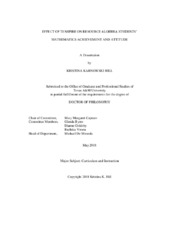| dc.contributor.advisor | Capraro, Mary M | |
| dc.creator | Hill, Kristina Karnowski | |
| dc.date.accessioned | 2019-01-17T17:40:06Z | |
| dc.date.available | 2020-05-01T06:23:09Z | |
| dc.date.created | 2018-05 | |
| dc.date.issued | 2018-04-27 | |
| dc.date.submitted | May 2018 | |
| dc.identifier.uri | https://hdl.handle.net/1969.1/173437 | |
| dc.description.abstract | The use of the calculator in a mathematics class has been studied and debated since the calculator was first introduced into the classroom. As the technology of calculators have evolved into interactive learning tools, little research could be found about the effects of an interactive calculator on the mathematical achievement and attitudes of students with disabilities. To determine if the TI Nspire handheld calculator is effective in increasing mathematical achievement and attitudes of students with disabilities, a qualitative-dominant mixed method approach was used. Interviews with an Algebra I teacher of students with disabilities were held to determine the teacher’s perception of teaching with the TI Nspire. Interviews with students in Resource Algebra I classes were held to ascertain the mathematical attitudes of the students while pre- and post-test scores from students at the beginning and end of the course were analyzed quantifiably.
Pre- and post-tests from the control group were administered during the second half of their Algebra I course. The intervention group were administered the pre- and post-tests during the first half of their Algebra I course with an additional pre-test given at the beginning of the second half of their Algebra I course. Analysis resulted in no statistically significant differences; however, with effect sizes of Cohen’s d between 0.121 and 0.541, a level of practical significance was found.
Interviews with six students from the control group and eight students from the intervention group were held to ascertain student attitudes towards mathematics.
Statements from the interviews were coded as positive, negative, and neutral. Results determined the overall statements provided by the intervention group contained 6% more positive than negative statements. Statements provided by the control group were more negative than positive by 2%.
A pre-intervention and post-intervention interview was conducted with the teacher of the Algebra I classes. Statements provided by the teacher were coded as positive, negative, neutral, and example. The teacher’s attitude toward the use of the TI Nspire as a teaching tool became more positive as evidenced by the increase in positive statements from the pre-intervention to post-intervention interview. | en |
| dc.format.mimetype | application/pdf | |
| dc.language.iso | en | |
| dc.subject | mathematical achievement | en |
| dc.subject | mathematical attitude | en |
| dc.subject | graphing calculator | en |
| dc.title | Effect of Ti Nspire on Resource Algebra Students’ Mathematics Achievement and Attitude | en |
| dc.type | Thesis | en |
| thesis.degree.department | Teaching, Learning, and Culture | en |
| thesis.degree.discipline | Curriculum and Instruction | en |
| thesis.degree.grantor | Texas A & M University | en |
| thesis.degree.name | Doctor of Philosophy | en |
| thesis.degree.level | Doctoral | en |
| dc.contributor.committeeMember | Byrns, Glenda | |
| dc.contributor.committeeMember | Goldsby, Dianne | |
| dc.contributor.committeeMember | Viruru, Radhika | |
| dc.type.material | text | en |
| dc.date.updated | 2019-01-17T17:40:06Z | |
| local.embargo.terms | 2020-05-01 | |
| local.etdauthor.orcid | 0000-0003-1357-7805 | |


